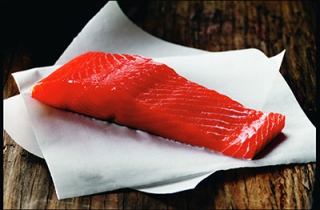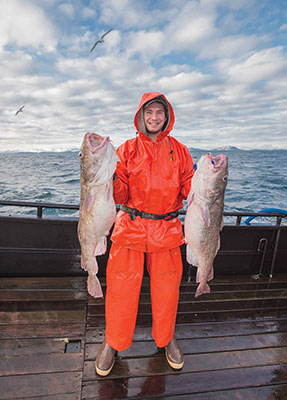
Sustainable, Certified and Cooked from Frozen – Alaska Seafood Paves the Way for Wild-Caught Practices
31 May 2017For over 50 years, Alaska’s fisheries have been regulated to insure wild-caught Alaska seafood is plentiful for years to come.
By the Alaskan Seafood Marketing Institute
 Sustainability
Sustainability
From fisherman to supplier, chef to diner – we all have a role to play ensuring that sustainable seafood lands on our plate. In Alaska, sustainable seafood is so critical that it is written into the state constitution mandating that “fish… be utilized, developed and maintained on the sustained yield principle.” In this way, Alaska promises to provide wild-caught seafood for generations to come.
Alaska supplies more than half of the wild-caught seafood in the United States and is home to the greatest salmon runs in the world, providing as much as 95 percent of North America’s wild salmon. With seafood touching the lives of most Alaskans in one way or another, it is no surprise that Alaskans are long-standing believers in sustainability.
The seafood industry is the largest private-sector employer in the state, providing jobs and income for more than 52,000 people. The livelihoods of these fishermen depend on healthy wild fish stocks. Alaska’s fishermen have been instrumental in helping to reshape the industry with science-based resource management and environmental stewardship to ensure the long-term sustainability of the fisheries that support them.
Responsible fisheries management and sustainable fishing practices involve preserving the fish stocks against overfishing, and taking care not to harm other marine animals and the surrounding marine environment. State, federal and international organizations all work together to manage and oversee Alaska’s fisheries. This means every aspect of Alaska’s fisheries are strictly regulated, closely monitored and rigidly enforced -- and this has been the case for over five decades.
One way of providing assurances of sustainable practices is the use of seafood certification programs; however, the increase of certification programs, eco-labels, and consumer watch lists have led to confusion for many. The simplest way to guarantee that your seafood is sustainable is to buy Alaska seafood because that’s the only kind of fish the state harvests.
That’s why pioneer of world cuisine Mary Sue Milliken and her co-chef/co-owner Susan Feniger of critically acclaimed Border Grill restaurants, appreciate working with wild-caught Alaska seafood.
“Since we opened Border Grill in 1985, we have been advocating for healthy and sustainable food sources. Our customers and staff are both interested and grateful for our diligence in sourcing only the best. Alaska has been a leader in managing and sustaining wild caught seafood forever – it’s even written in their constitution!” says Chef Milliken. “So, when we get seafood from Alaska, not only am I assured it is sustainable, but the natural and varied diet produces incredible flavor making my job as a chef incredibly easy. All I have to do is get out of the way and let the natural seafood flavors shine on the plate.”
Certification for Responsible Management
There are numerous organizations providing third-party certification for responsible management and sustainability, and the vast majority of Alaska's seafood bears at least one type of certification. In particular, the following Alaska fisheries are Responsible Fisheries Management (RFM) Certified: Alaska Salmon, Alaska Halibut, Alaska Cod, Alaska Black Cod/Sablefish, Alaska Pollock, Alaska Flatfish and Alaska Crab.
The Alaska RFM Program is a comprehensive seafood certification program founded on the strongest and most widely acknowledged international standards and practices – based on United Nations Food and Agriculture Organization (FAO) criteria. RFM is a voluntary accredited assessment of whether a fishery meets strict criteria to be certified as meeting “responsible fisheries management.” Chefs can be confident in Alaska RFM Certification because it means the fisheries in Alaska are assessed against the world’s highest and most internationally accepted standard.
In addition, RFM has a complete Chain of Custody program, providing assurance to buyers that RFM certified fish can be traced through the supply chain back to its origin – a certified fishery.
Even more importantly, Alaska RFM is the first certification program to be recognized by the Global Sustainable Seafood Initiative’s (GSSI) Global Benchmark Tool as meeting all applicable criteria. This recognition should ensure confidence in the credibility of Alaska RFM Certified seafood. The GSSI Alaska RFM Benchmark Report is available here.
COOK IT FROZEN! Techniques
With Alaska Seafood Marketing Institute’s (ASMI) simple, time-saving COOK IT FROZEN! techniques, chefs can prepare healthy meals with frozen Alaska seafood portions in as little as 15 minutes – with no thawing or pre-planning needed. Cooking frozen fish may seem intimidating at first, but ASMI has mastered the process and provided tips for chefs to use in familiar cooking methods including sautéing, roasting, broiling, steaming, poaching and grilling. Below are some of the recommendations:
- Rinse seafood under COLD water to remove any ice glaze for all cooking methods
- When roasting, broiling or grilling, brush both sides of fish with high oleic vegetable oils such as olive, canola, peanut, grapeseed, soy or safflower instead of butter, sunflower or corn oil as they will burn at high heat
- When steaming, line the steamer with lettuce, onion, herbs or citrus (without covering all the holes) to keep seafood from sticking
- Remove fish from heat just as soon as seafood is opaque throughout
Recipes and ACF Continuing Education Hours
The American Culinary Federation offers five continuing education hours (CEHs) for completing the Alaska Seafood Wild Style. Click here to learn more about Alaska salmon and take the quiz to earn CEHs. Chefs can click here for recipes featuring wild-caught Alaskan seafood including Halibut and Cod tacos.
